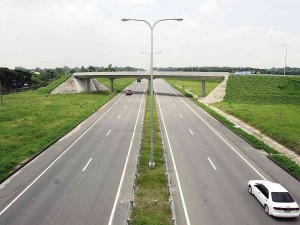Central Luzon new ‘epicenter’ for property investments

THE SUBIC-CLARK-TARLAC Expressway (SCTEX) is designated as the new economic backbone for Central Luzon and adjoining regions that will provide wider investment, trade and employment opportunities. The country’s longest expressway at 93.77 kilometers, it interconnects the three major economic zones in Central Luzon-Subic Bay Freeport Zone, Clark Freeport Zone and the Central Techno Park in Tarlac. NIÑO JESUS ORBETA
If you build it, they will come north of Manila.
The convenience of transport made possible by the improved North Luzon Expressway (NLEx), the scenic Subic-Clark-Tarlac Expressway (SCTEx) and the planned expansion of the Clark International Airport (formerly Diosdado Macapagal International Airport) has been largely responsible for jumpstarting property developments and attracting local and foreign investments in Central Luzon northward.
For the past couple of years, local property giants have staked their claims in this wide 21,470-square-kilometer swath of land that encompasses seven provinces (Aurora, Bataan, Bulacan, Nueva Ecija, Pampanga, Tarlac and Zambales). Examples are Ayala Land’s Marquee Residences in Angeles, Pampanga; Robinsons Land’s nine housing developments in Pampanga, Tarlac and select locations in Northern Luzon (Ilocos Norte and Laoag City); and Ayala Land Premier’s Anvaya Cove in Morong, Bataan.
Foreign investors have also been eyeing the Central and Northern Luzon regions, according to property consultant CB Richard Ellis. The firm said investors were particularly focused on the Clark and Subic Freeport Zones, and on strategic locations in the Northern Luzon Urban Beltway (NLUB). In the pipeline for the region are mixed-use developments, an aeropark, a business park, hospitals, leisure tourism estates, condominiums, golf courses, an ecopark, an international school and a shopping arcade.
CBRE’s “The Central Luzon Market” report, furnished to Inquirer Property last week, indicated that the NLUB has been “transforming its landscape into a high potential investment destination” and that this has been “brought about by infrastructure developments that paved way to increased economic activity in Central Luzon as businesses started expanding from Metro Manila to its peripheries.”
CIA new gateway to PH
The key project that the region’s development hinges on, according to CBRE, is the Clark International Airport, which was built in 2008 and is up for significant expansion. CIA has been “envisioned to be the primary international gateway of the country, with the Ninoy Aquino International Airport (Naia) already operating at maximum capacity,” said the report.
CBRE added that CIA is expected to increase its passenger capacity to more than 2 million annually. The government is studying the possibility of maintaining the two main airports (CIA and Naia) side by side, or just designating CIA as the country’s main airport.
“Anticipating these developments, investors are now pouring in multiple high-value investments in Clark and Subic Freeport Zones and in other areas of the NLUB,” the report said.
CBRE cited as an example Clark’s upcoming Global Gateway Logistics City, a 177-hectare mixed-use development composed of a logistics park, an aeropark, a business park and a neighborhood town center. Once completed, the development will also feature a 150-bed tertiary hospital, which will be leased, equipped and operated by The Medical City starting this year.
Donggwang Clark Corp., a South Korean firm, has likewise started construction of its 304-hectare leisure tourism estate. Its three-tower condominium complex was turned over in 2012, and the construction of its 36-hole golf course and clubhouse has commenced.
Other projects to be developed within the complex include a water park, spa and gymnasium, ecopark, business center, specialty stores and function rooms, an international school, a golf academy and driving range, a clinic and drugstore, a hotel, casino, a 500-unit villa complex and a shopping arcade.
The rapid property developments have resulted in Central Luzon’s prominent economic standing. The CBRE report said: “Central Luzon is now the third biggest contributor to the national economy with 9.1-percent share of the GDP in 2010. In 2011, the region posted the highest Gross Regional Domestic Product growth in the country at 11.9 percent, higher than the National Capital Region (7.5 percent) and Calabarzon (5.6 percent).”
It added: “The labor pool is one of the region’s core competencies. A total of 56,800 tertiary graduates were recorded in 2012, making it the second largest source of labor next to NCR.”
